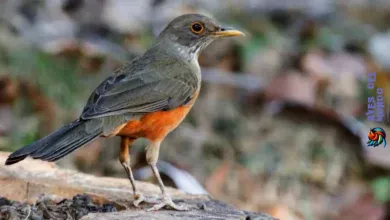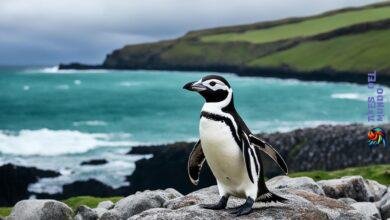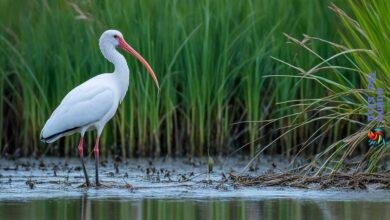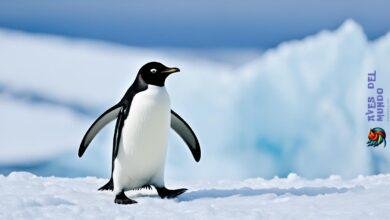Ever wondered how penguins survive in the sub-Antarctic’s harsh conditions? Or adapt to the freezing southern waters of South America? Meet the Rockhopper penguin – it defies the odds every day. In this article, we explore their unique habitats and behaviors. We’ll look at their amazing adaptations and the survival challenges they face.
But first, let’s check out the Rockhopper penguin’s looks. They have a wild punkish crest of yellow and black feathers, black bodies, and flippers, with white bellies and striking red eyes. Rockhopper penguins stand out in any crowd.
Yet, there’s more to these birds than meets the eye. Beneath their bold exterior lies a world of secrets. Are you ready to explore the life of the Rockhopper penguin? Let’s dive into their world!
Rockhopper Penguin Habitat
Rockhopper penguins are fascinating creatures that adapt well to their unique habitats. They live on the rocky shorelines of islands north of Antarctica. This includes places like the Falkland Islands, stretching over to Chile and New Zealand. These areas are perfect for the penguins.
Rockhopper penguins prefer rocky, windy places. They are often found in areas with tall grasses called tussocks. These grasses are great for hiding and protecting their homes. The penguins make burrows among these grasses. This provides a safe place for them and their young ones.
The home of Rockhopper penguins is rough and windswept. Despite the strong waves and winds, these penguins are well-suited to their environment. They have strong, webbed feet for moving over rocks and getting to the ocean to find food.
Rockhopper penguins are also used to cold waters. Their thick feathers and fat keep them warm in the cold sea. These traits help them dive deep and swim far to catch their food.
Threats to Rockhopper Penguin Habitat
Rockhopper penguin homes face dangers due to human actions. Pollution, too much fishing, and climate change are big problems. These issues can reduce food sources and harm their living spaces.
To help Rockhopper penguins, we must protect their homes. We can do this by spreading the word, fishing responsibly, and creating safe areas for them. Such steps will help keep these amazing penguins safe and sound.
| Threats to Rockhopper Penguin Habitat | Impact |
|---|---|
| Pollution | Can contaminate the waters and affect the availability of prey. |
| Overfishing | Reduces the abundance of fish and krill, essential food sources for Rockhopper penguins. |
| Climate Change | Alters ocean currents and temperature, disrupting the delicate balance of the ecosystem. |
Rockhopper Penguin Diet
Rockhopper penguins are total meat-eaters. They eat a lot of different foods to stay healthy and ready for making babies.
Krill are like tiny shrimp and super important for them. These little guys give Rockhopper penguins the proteins and fats they need to grow and stay healthy.
But, krill isn’t their only food. Fish matter too, giving them even more protein and good fats. These birds are great at spotting and catching fish in cold waters.
They also like squid and mollusks. These give them new tastes and help mix up their diet. Eating different foods keeps them strong and healthy.
Every day, Rockhopper penguins go to the sea to find food. They dive and swim using their flippers and sleek bodies. They’re really good at finding and catching what they eat.
Their diet is key to living well in tough places and having baby penguins. The right food gives them energy and everything they need to deal with their harsh homes. They’ve become pros at eating what’s around to survive.
| Food Sources | Nutritional Benefits |
|---|---|
| Krill | Provides essential proteins and lipids |
| Fish | Rich source of proteins and omega-3 fatty acids |
| Squid | Offers diversity in texture and flavor |
| Mollusks | Provides additional nutrients and variety |
Rockhopper Penguin Adaptations
Rockhopper penguins have amazing adaptations for living in tough places. These traits help them survive. They deal with cold waters and extreme weather.
One big adaptation is their layered warmth-keeping system. They have a fat layer, called blubber, keeping them warm in cold water. Next, they have down feathers trapping air for more warmth. Finally, their waterproof feathers keep them dry, warm, and comfy in the water.
Rockhopper penguins also see very well, above and under water. Their eyes adjust to different lights and help them find food. Seeing well is key for avoiding danger and catching meals.
Their wings work like flippers for swimming. They don’t fly but can move fast in water. Their body and strong flippers help them against currents and waves. This makes them good at hunting and diving.
In short, Rockhopper penguins’ adaptations are amazing for their survival. These traits help them find food, breed, and care for their babies in tough environments.
Rockhopper Penguin Adaptations Summary
Summing up Rockhopper penguin adaptations, they have:
- Layered insulation with blubber, down feathers, and waterproof feathers.
- Great vision for hunting and avoiding predators.
- Flipper-like wings for swimming well.
These adaptations help Rockhopper penguins thrive in hard environments. They are truly remarkable creatures.
Rockhopper Penguin Behavior
Rockhopper penguins love hanging out together. They show exciting behaviors that help them live and make more penguins. They’re always talking and sometimes fighting in their big groups.
Aggression for Survival: Rockhopper penguins can get pretty tough. They fight over the best spots to nest, who gets to mate, and finding enough food. This means only the toughest penguins get what they need for their babies.
Body Language and Vocalizations: They talk with their bodies a lot. They bow, shake their heads, and clean themselves to send messages. They also make loud sounds to find their family in the crowded places they live.
«These penguins have a super-smart way of talking to each other that helps them get along.»
Rockhopper penguins use their unique ways to figure out who’s boss. Scientists learn a lot by watching how they act with each other. These birds really know how to live together.
Rockhopper Penguin Behavior Highlights:
- Aggressive displays and fights for nesting sites, mating rights, and food.
- Body-based signals, such as bowing, shaking heads, and preening, used for communication.
- Loud vocalizations called «braying» to locate mates and chicks within breeding colonies.
| Behavior | Description |
|---|---|
| Aggression | Rockhopper penguins exhibit aggressive behavior when it comes to defending their territories and resources. |
| Body Language | They communicate through body-based signals, such as bowing, shaking their heads, and preening. |
| Vocalizations | Rockhopper penguins emit loud vocalizations known as «braying» to locate their mates and chicks amidst the breeding colony. |
Rockhopper Penguin Population and Conservation Status
The Rockhopper penguin population is a concern. It has gone down a lot in recent years. Now, there are about 1.5 million breeding pairs worldwide. Yet, this is much less than before because their numbers have fallen over 30% in the last 30 years.
Their numbers are dropping due to human actions. Things like overfishing, pollution, and destroying their homes have hurt them. These birds need clean oceans to live, but less fish and more pollutants make it hard for them.
Because of these problems, the International Union for Conservation of Nature (IUCN) says Rockhopper penguins are vulnerable. This shows we need to act fast to save them from getting even closer to extinction.
Many groups worldwide are trying to help. They’re working to protect these penguins by creating safe ocean areas, fishing wisely, and teaching people why it’s important to keep their homes safe. These steps are key to their survival.
If we all help protect the Rockhopper penguins and where they live, we can make sure they stay around. We get to continue enjoying these wonderful birds in the wild.
Conservation Status Overview:
| Conservation Status | Description |
|---|---|
| Vulnerable | The Rockhopper penguin population is declining and at risk of extinction due to various human-induced factors such as commercial overfishing, pollution, and habitat destruction. |
Rockhopper Penguin Breeding
Rockhopper penguins start their breeding each year in a unique way. First, the males arrive at the breeding sites. Then, the females join them. They pick the same partner every year and use the same nest.
During this time, females lay two eggs. But, often only one survives. The challenging habitat is a big reason for this. Both parents take turns keeping the eggs warm for about a month. This helps their babies develop well.
After hatching, the parents feed the chicks fish. They regurgitate it to nourish their young. This feeding helps the chicks get strong and ready for the future.
«The dedication and cooperation exhibited by the Rockhopper penguin parents during the breeding process are truly remarkable. By taking turns to incubate the eggs and providing nourishment to their chicks, they show a strong commitment to the survival of their offspring.»
The young penguins then gather in a crèche. Here, they socialize and learn to survive. Forming bonds with other chicks is a key part of their growth.
This breeding stage is crucial for keeping Rockhopper penguins around long-term. It shows how the species can handle their tough environment.
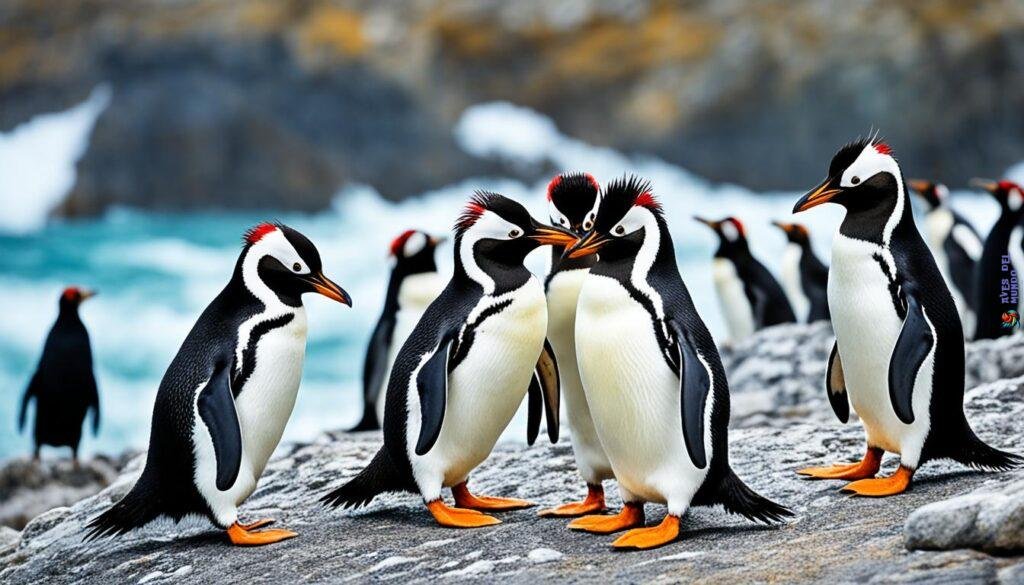
The Importance of Rockhopper Penguin Breeding
Breeding is key for the Rockhopper penguin population. It leads to successful offspring creation. It also helps the species face environmental problems.
To help, we should protect their breeding areas and take steps to keep their home safe. Doing this will support Rockhopper penguins and their breeding efforts.
Rockhopper Penguin Characteristics
Rockhopper penguins are easy to spot in the wild. They stand about 50 cm tall, making them one of the smaller penguin kinds. They are known for their unique mix of colors and features.
They have black bodies and flippers, paired with white bellies. Their heads are adorned with yellow and black crests. This unique look makes them stand out. Their red eyes and red-orange beaks add to their special appearance.
«With their punkish crests and vibrant colors, Rockhopper penguins are truly a sight to behold. Their unique appearance adds to the charm and allure of these charismatic creatures.»
Their color serves more than just looks. Their dark flippers and bodies soak up sunlight. This keeps them warm in cold waters. Their crests might help them recognize each other in their groups.
When we learn about Rockhopper penguins, we see how diverse the animal world is. These penguins are fascinating to study and amazing to see in the wild.
Rockhopper Penguin Characteristics
| Characteristic | Description |
|---|---|
| Size | About 50 cm tall (among the smallest penguin species) |
| Color | Black bodies and flippers, white bellies |
| Crest | Yellow and black feathers on the head |
| Eyes | Red |
| Beak | Red-orange |
These traits, along with their behavior and how they adapt, make Rockhopper penguins stand out. Their looks and way of life capture the attention of all who see them.
Rockhopper Penguin Lifespan
Rockhopper Penguins are interesting because they live about 10 years in the wild. This can change due to many factors that affect their survival.
Rockhopper penguins deal with various challenges. These challenges include predators, finding food, and the state of their living area. These play a big part in how long they live.
Predators pose a big risk to Rockhopper penguins. On land, birds like the Brown Skua threaten their eggs and young during the breeding time. In the sea, they must avoid seals, sharks, and orcas that can eat them.
The availability of food is crucial for the Rockhopper penguin’s life. They eat krill, fish, squid, and other small sea creatures. If these food sources go down, it can hurt their health and life span.
The state of their habitat also affects their survival chances. Pollution and destroying their homes can lower their life expectancy. Saving their habitats is key to their survival.
Knowing what affects their lifespan shows how tough Rockhopper penguins are. They have found ways to face these challenges. This shows their amazing ability to survive tough situations.
Rockhopper Penguin Predators
Rockhopper penguins face dangers from land and sea enemies. These threats shape their survival skills and life.
Land Predators
On their island homes, Rockhopper penguin eggs and chicks are at risk. The Brown Skua, a bird that loves to steal, often targets them. These birds are experts at finding easy meals in penguin colonies.
Sea Predators
In the ocean, Rockhopper penguins meet different threats. Seals, like the leopard and fur seals, prey on them. These agile hunters catch penguins by surprise from below.
Sharks pose another danger in the water. The great white and mako sharks share the penguins’ ocean. Their fast and quiet approach makes them scary enemies.
Killer whales, or orcas, also hunt Rockhopper penguins. These smart and powerful predators work together to trap their prey.
Rockhopper penguins stand up to these dangers. They guard their young and homes fiercely.
Despite the odds, they keep adapting and surviving. This shows their strong will to live.
| Predators | Description |
|---|---|
| Brown Skua | Opportunistic predatory bird that targets penguin eggs and chicks on land. |
| Seals | Including leopard seals and fur seals, hunt Rockhopper penguins in the sea. |
| Sharks | Great white sharks and mako sharks are known to prey on Rockhopper penguins. |
| Killer Whales (Orcas) | Highly intelligent predators that use coordinated hunting techniques to capture Rockhopper penguins. |

Rockhopper Penguin Fun Facts
Find out what makes Rockhopper penguins so special and interesting!
- Rockhopper penguins have the most feathers of any bird, with up to 12 feathers per square centimeter.
- They can change the shape of their eye lenses. This lets them see well both in and out of water.
- Rockhopper penguins are famous for their hopping on land. This makes them different from other penguins.
- They use a loud sound called «ecstatic vocalization» to talk to each other.
Rockhopper penguins have amazing skills and behaviors. These help them live in tough places.
Rockhopper Penguin Fun Facts
| Fun Fact | Description |
|---|---|
| Highest Feather Count | Rockhopper penguins have the most feathers of any bird, with up to 12 feathers per square centimeter. |
| Flexible Vision | They can change the shape of their eye lenses, allowing good vision everywhere. |
| Unique Hopping Movement | Rockhopper penguins are known for their unique hopping on land. This sets them apart from other penguins. |
| Loud Vocalization | They use a loud «ecstatic vocalization» to communicate with one another. |
Rockhopper penguins are fascinating because of their unique traits and adjustments. This makes them captivating animals.
Rockhopper Penguin Conservation Efforts
Saving Rockhopper penguins and their homes is very important. We can really help them by doing the right things. Their future depends on our actions.
It’s crucial to cut down on overfishing and control sea pollution. This helps their living space stay healthy. Keeping fish numbers up and pollution down supports their survival.
We also need to create safe areas for them. These places let them live without disturbances. Here, they can find food, breed, and take care of their young.
Many groups help in saving these penguins. Organizations, researchers, and governments must work together. By joining forces, we make a big difference for these unique birds.
